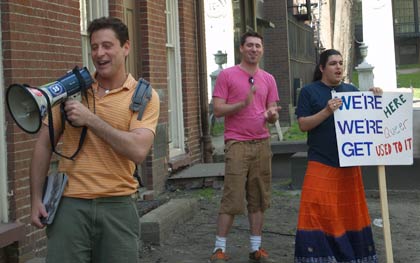Quote: Originally posted by aCultureWarrior
God has a special place in Heaven for people like Joseph Nicolosi.
Rest in peace Dr. Joseph Nicolosi, knowing that your work helping others will continue.
will that place be next to the millions of gays and lesbians that he tortured?
Healing Homosexuality:
Case Stories of Reparative Therapy
Repairs Self-Esteem and Relatedness
"...Central to reparative therapy is the client's understanding of how his masculine deficit becomes projected onto idealized males--"The other man has something I lack--therefore I need to be close to him [sexually]."
Reparative therapy is initiatory in nature. It requires not just a passive musing over self-insights, but an active initiation of new behaviors. The client must struggle to break down old patterns of avoidance and defensive detachment from males in order to form close, intimate, non-sexual male friendships.
Therapy challenges the client to master gender-related tasks missed in early boyhood. His developmental path requires mastering of these tasks during adulthood.
He is called to "catch up" to what the heterosexual man achieved years before. Thus he may eventually arrive at a heterosexual place, but from a different direction.
Many early feelings toward the father and other significant male figures will be transferred onto the male therapist. Therapy will offer a valuable opportunity to work through these reactions. Feelings for the male therapist may include anticipation of rejection and criticism, a tendency toward dependency--including hostile dependency--and also sexual feelings and anger.
Like all psychotherapies, reparative therapy creates a meaning transformation. This meaning transformation is the result of the client's gains in insight. When he comes to see the true needs that lie behind his unwanted behavior, he gains a new understanding of this behavior. His unwanted romantic attractions are de-mystified. He begins to perceive them as expressions of legitimate love needs--attention, affection and approval from men--which were unmet in childhood. He learns that such needs indeed can be satisfied, but not erotically.
When this is understood, there is a meaning transformation--"I do not really want to have sex with a man. Rather, what I really desire is to heal my masculinity." This healing will occur when the legitimate love needs of male attention, affection and approval are satisfied.
Meaning transformation includes not just intellectual understanding (insight) but also the experience of the self in the doing of new behaviors.
Embodied experience--that is, the experience of the body in the world in a new way--transforms personal identity. Transformation in personal identity occurs through repeatedly feeling different about oneself in relationship to others. In the case of gender deficit and homosexuality, increased ownership of one's maleness diminishes erotic attraction toward other men. The gradual internalization of the sense of "masculinity as me" distances previously distressing temptations.
In recent years, Gay Affirmative Therapy (GAT) has emerged to help homosexuals accept and affirm their sexual orientations. GAT presumes that dissatisfied homosexuals would be "satisfied" if they could only be free of the internalized prejudices of society. GAT sees reparative therapy as playing on a man's self-deception, guilt and low self-esteem. It makes the arbitrary assumption that "coming out" is the answer to every homosexual client's problems.
Reparative therapy, on the other hand, sees homosexuality as a developmental deficit. According to reparative theory, Gay Affirmative Therapy is expecting the client to identify with his pathology in the name of health.
William Aaron, in his biographical book, Straight, says: "To persuade someone that he will make a workable adjustment to society and himself by lowering his sights and settling for something that he inwardly despises (homosexuality) is not the answer."
GAT presumes that homosexuality is a natural and healthy sexual variation. It then proceeds to attribute every personal and inter-personal problem of the gay man to social or internalized homophobia. Its theoretical model frames the life experiences of the client in the context of victimization, inevitably setting him against conventional society.
One cannot help but wonder how GAT would explain the obvious benefits of reparative therapy---increased self-esteem, with a diminishing of distress, anxiety and depression. Better relationships with others and freedom from distressing distractions are typically reported by men in reparative therapy.
Interestingly, GAT and reparative therapy agree on what the homosexual man needs and desires: To give himself permission to love other men. But GAT works within the gay ideology of eroticization of these relationships, while reparative therapy sees sex between men as sabotaging the mutuality necessary for growth toward maturity. Reparative therapy frees the homosexual man to love other men--not as sex partners, but as equals and as brothers."
Read more:
http://www.josephnicolosi.com/healing-homosexuality-excerpts/




